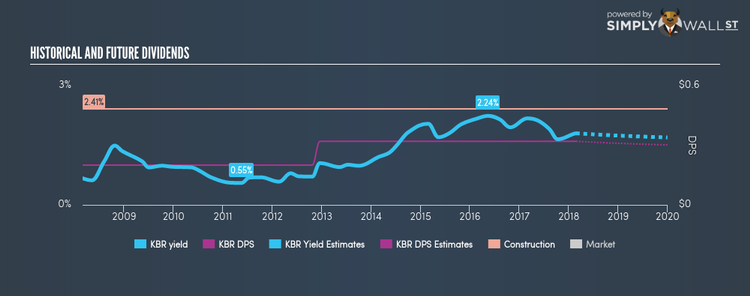Is KBR Inc (NYSE:KBR) An Attractive Dividend Stock?

Dividends play a key role in compounding returns over time and can form a large part of our portfolio return. In the past 10 years KBR Inc (NYSE:KBR) has returned an average of 1.00% per year to investors in the form of dividend payouts. Should it have a place in your portfolio? Let’s take a look at KBR in more detail. See our latest analysis for KBR
5 checks you should do on a dividend stock
When researching a dividend stock, I always follow the following screening criteria:
Is it the top 25% annual dividend yield payer?
Has it paid dividend every year without dramatically reducing payout in the past?
Has dividend per share amount increased over the past?
Does earnings amply cover its dividend payments?
Will it be able to continue to payout at the current rate in the future?
How does KBR fare?
The company currently pays out 63.57% of its earnings as a dividend, according to its trailing twelve-month data, meaning the dividend is sufficiently covered by earnings. In the near future, analysts are predicting lower payout ratio of 20.88%, leading to a dividend yield of around 1.72%. However, EPS should increase to $1.38, meaning that the lower payout ratio does not necessarily implicate a lower dividend payment. If dividend is a key criteria in your investment consideration, then you need to make sure the dividend stock you’re eyeing out is reliable in its payments. KBR has increased its DPS from $0.2 to $0.32 in the past 10 years. During this period it has not missed a payment, as one would expect for a company increasing its dividend. These are all positive signs of a great, reliable dividend stock. Relative to peers, KBR generates a yield of 1.80%, which is on the low-side for Construction stocks.
Next Steps:
Keeping in mind the dividend characteristics above, KBR is definitely worth considering for investors looking to build a dedicated income portfolio. Given that this is purely a dividend analysis, I urge potential investors to try and get a good understanding of the underlying business and its fundamentals before deciding on an investment. There are three relevant factors you should further examine:
1. Future Outlook: What are well-informed industry analysts predicting for KBR’s future growth? Take a look at our free research report of analyst consensus for KBR’s outlook.
2. Valuation: What is KBR worth today? Even if the stock is a cash cow, it’s not worth an infinite price. The intrinsic value infographic in our free research report helps visualize whether KBR is currently mispriced by the market.
3. Other Dividend Rockstars: Are there better dividend payers with stronger fundamentals out there? Check out our free list of these great stocks here.
To help readers see pass the short term volatility of the financial market, we aim to bring you a long-term focused research analysis purely driven by fundamental data. Note that our analysis does not factor in the latest price sensitive company announcements.
The author is an independent contributor and at the time of publication had no position in the stocks mentioned.

